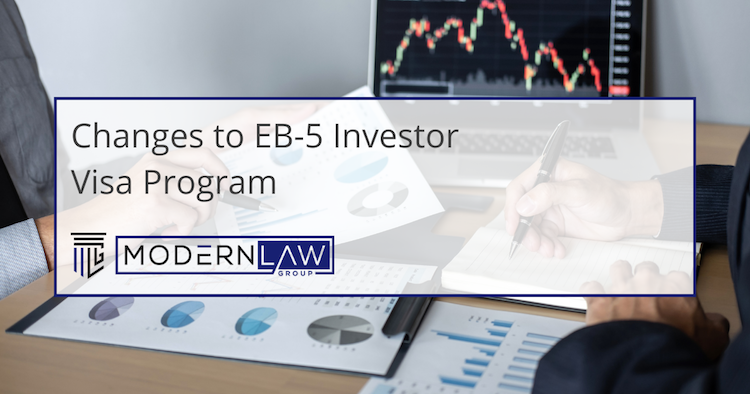Changes to EB-5 Investor Visa Program

U.S. Citizenship and Immigration Services (USCIS) announced important changes to the EB-5 Immigrant Investor Program that offers permanent residence status with investment in a U.S. commercial enterprise that creates or, under specific conditions, maintains 10 full-time jobs within U.S.
EB-5 changes which went into effect on November 21, 2019 include:
- Increased minimum investment amounts:
- Standard investment increase from $1 million to $1.8 million
- Targeted Employment Area (TEA) investment increase from $500,000 to $900,000
- Investment amounts raised every five years
- Clarifying USCIS procedures for removal of conditions on permanent residence
- Allowing EB-5 petitioners to retain original priority date
Let’s look into it.
On July 24, 2019, U.S. Citizenship and Immigration Services (USCIS), issued a final regulation on "EB-5 Immigrant Investor Program Modernization" (the "Rule") to improve the EB-5 program in the Federal Register. The Rule takes effect on November 21, 2019.
The rule announces a prominent modification in the EB-5 program, including a significant increase in the investment threshold, and granting exclusive authority to USCIS to determine Targeted Employment Areas (TEAs), as well as for the USCIS to maintain priority dates for petitioners.
The changes imposed by the Rule include the following:
- Increasing minimum non-TEA investment by 80% – from $1 million to $1.8 million with automatic adjustments based on increases in the Consumer Price Index for All Urban Consumers (CPI-U) every five years;
- Raising the TEA investment by 80% – from $500,000 to $900,000. In the event of subsequent adjustment to the minimum non-TEA investment, the minimum TEA investment will be automatically adjusted to maintain 50% of minimum non-TEA investment, keeping the current ratio between the 2 investments;
- Removing state’s authority to nominate TEAs with high unemployment, thereby giving USCIS private authority to nominate TEAs;
- Changing the definition of which physical locations qualify for a TEA;
- Approval for the EB-5 investor to preserve the priority date (for the purposes of the immigration visa quota) in case, for example, the regional center stops working by filing a new petition and confirming the lack of significant changes in their investments other than disclosure obligations in laws resulting from new requirements of the rule; and
- Permitting the imitative family members (i.e. the spouse and children) of an EB-5 investor to file their own petitions if they were not included in the primary investor’s original petition.
The changes in the requirements for qualifying as a TEA include the following:
- Allowing cities and towns with a population of 20,000 or more outside of a Metropolitan Area to potentially qualify as TEAs based on high levels of unemployment;
- If a new commercial enterprise (new business entity) ("NCE") is located in several registered areas, which allows the addition of adjacent registered areas in which NCE mainly does business, as long as the average unemployment rate for the included areas is not less than 150% of the national average; and
- Allowing the addition of both adjacent registered areas in which NCE is mainly engaged in business, and any neighboring areas as long as the average of the unemployment rate for the areas included is at least 150% of the national average;
- The primary effect of the changes in the TEA designation process is likely to be that obtaining a TEA label will become more stable with an exclusive agency (USCIS) responsible for TEA labeling, and more difficult in that there will be greater limitations on the registered areas that can be used to include a TEA.
The Rule expressly states that the petitions filed before the effective date will be regarded based on the eligibility standards in effect as of the date when the petition was filed. Consequently, investors who both invested and filed their petition prior to November 21 would fall under previous ruled. Investment alone is no longer sufficient.
The Rule further states that there will be no loss of an investor’s immigrant visa priority date if there are any revisions to the project documents that may be required as a result of investor disclosures under the laws due to the changes in the EB-5 program employed by the Rule. It is yet to be seen how USCIS will practice this provision since the agency has kept in place its current policy which creates a loss of priority date if a new petition is required.
Call us today for a free consultation 888-902-9285.
 USA Immigration Lawyer Modern Law Group, P.C. Home
USA Immigration Lawyer Modern Law Group, P.C. Home






 Deron E. Smallcomb If you have a fiancé or spouse in another country, a parent that you'd like to bring to the USA...
Deron E. Smallcomb If you have a fiancé or spouse in another country, a parent that you'd like to bring to the USA...


